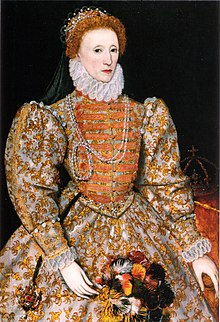 The Elizabethan era was between 1558 - 1603, during Queen Elizabeth 1st's reign. The Elizabethan era was a time of many different changes. For example; England's population rose from 3.2 million to 4.1 million - which was more than a 25% increase.
The Elizabethan era was between 1558 - 1603, during Queen Elizabeth 1st's reign. The Elizabethan era was a time of many different changes. For example; England's population rose from 3.2 million to 4.1 million - which was more than a 25% increase.Mid 16th century England was practically torn apart by religion. The two major religions throughout the period were the Catholic and Protestant beliefs. The official religion of the country was changed from Catholic to Protestant, to Catholic and then back again within 12 years. The country was divided by the two religions and which one they should truly follow. Elizabeth constantly lived in the threat of being assassinated by Catholics who wanted Mary Queen of Scots to take the throne.
The Elizabethan era was a time for world wide exploration. It saw the rise in the English Navy as well as Sir Thomas Drake after he successfully circumnavigated around the globe. With more and more people travelling around the world, they inevitably produce back with them. Potatoes, tomatoes, tobacco and turkey were all considered exotic and an extreme luxury - many middle class houses would rather have potatoes and tomatoes as decoration on their tables to show their wealth and status than to eat. It also saw major developments for the general home; chimneys were made available for the middle class which combined with the mass production of cheap bricks, meant that people were able to build multistory houses that remained warm throughout the entire year. From 1598 glass became increasingly popular - even if many homes only had it at the front of their buildings as a status symbol whilst making do with shutters at the back. Many old and outdated homes were being destroyed with new ones with new materials being built in their place - towns and cities were not only expanding but developing and improving.
As trade and industry flourished which helped improve the lives of the middle and upper class, those of the lower classes definitely did not benefit as much. As a land working on it's own produce, multiple bad harvests during the 1590's caused widespread poverty and starvation throughout the country. Cumbria, one of the poorest areas of England, had a six year famine from 1594. An outbreak of the plague in 1563 killed over 80,000 people in England and as healthcare was so reliant on the belief in God as well as suspicion, if you caught it - you didn't often survive.
Education was manly for boys/and or of the Upper Class. A Petty School was the name given to a primary school where children would have started at age 5 and learnt to read whilst being aided by the Lord's Prayer combined with the Ten Commandments. Girls were often allowed to attend a petty school, however, grammar education was primarily for the boys where they would be taught in Latin. Education was extremely stressed at home where children were taught basic etiquette and manners. Upper class girls, and sometimes boys, were often taught at home by tutors. During Elizabeth's reign the number of those who could read and write rose from 1 in 10 men, to 1 in 4 men. Women's statistics also rose, it went from 1% of women in the country being able to read and write to 10%.
No comments:
Post a Comment